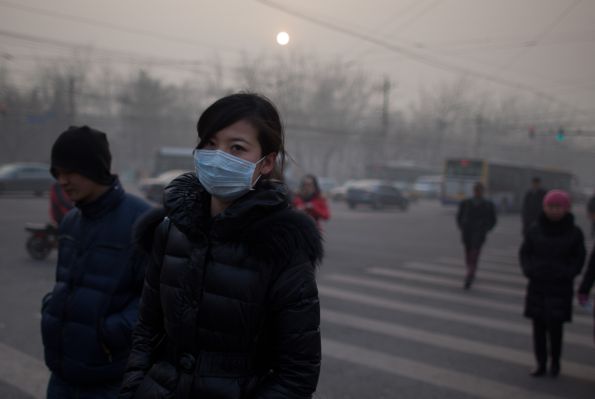雅思阅读背景素材:雾霾再次袭击北京(英)
2013/01/3003:34关键词:雅思阅读背景素材:雾霾再次袭击北京(英)
- 字体:
- 大
- 中
- 小
没有放晴几天的北京上空再次被雾霾所笼罩,针对这个时事热点,北京新航道小编为同学们整理了一篇相关新闻,希望同学们作为雅思阅读备考素材进行学习积累。译文见下一篇内容,记得关注哦~
【Beijing's air pollution-Blackest day】

ON January 12th of last year, in an article in the print edition of The Economist, we reported that the public outcry over Beijing’s atrocious air quality was putting pressure on officials to release more data about more kinds of pollutants. We also noted that Chinese authorities had already embarked on a wide range of strategies to improve air quality, and that they probably deserve more credit than either foreign or domestic critics tend to give them. But we concluded with the sad reality that such work takes decades, and that “Beijing residents will need to wait before seeing improvements.”
On January 12th of this year, Beijing residents got an acrid taste of what that wait might be like, as they suffered a day of astonishingly bad air. Pollution readings went, quite literally, off the charts. Saturday evening saw a reading of 755 on the Air Quality Index (AQI). That index is based on the recently revised standards of the American Environmental Protection Agency (the EPA), which nominally maxes out at 500. For more perspective, consider that any reading above 100 is deemed “unhealthy for sensitive groups” and that anything above 400 is rated “hazardous” for all.
Like many Beijing residents, your correspondent has mobile-phone apps that keep up with the pollution readings. At an otherwise pleasant Saturday-evening meal with friends, he joined his companions in compulsively checking for updates.
Those previously unseen numbers were hard to believe, but they did seem to match up well enough with the noxious soup we could see, smell and taste outside. We are all far more familiar with the specifics of air-quality measurement than we would like to be. Apart from the AQI readings above 700, we were quite struck to see the readings for the smallest and most dangerous sort of particulate matter, called PM 2.5, which can enter deep into the respiratory system. These are named for the size, in microns, of the particles. A reading at a controversial monitoring station run by the American embassy showed a PM 2.5 level of 886 micrograms per cubic metre; Beijing’s own municipal monitoring centre acknowledged readings in excess of 700 micrograms.
For perspective on that set of figures, consider that the guideline values set by the World Health Organisation regard any air with more than 25 micrograms of PM 2.5 per cubic metre as being of unacceptable quality.
Chinese authorities have complained about the American embassy's insistence on independently monitoring—and publicly reporting—Beijing’s air quality. And sometimes much is made of the vast differences between those readings and China’s own official ones, which are often less dire. Indeed, a key feature of one of those mobile-phone apps is the side-by-side comparison of those competing data-sets. (It is of course a bad sign that people here need more than one app to keep up with all this.)
But on a day like Saturday, the discrepancy between official readings and independent ones hardly seemed to matter; you didn't need a weatherman to know which way the ill wind blew. Or failed to blow, as the case may have been. One expert quoted by Chinese media attributed this spike in pollution to a series of windless days that allowed pollutants to accumulate.
But wind can be a problem when it does blow, too. In the outlying provinces that are part of Beijing’s airshed, there is a great deal of heavy industry. Pollution regulations are much harder to enforce there. And, in this colder-than-average winter, people have been burning more coal and wood than usual.
It is likely to be many more Januarys to come before China gets the upper hand on its air-pollution problems. Indeed, as we mentioned last January 12th, after nearly sixty years of trying and a vast amount of progress, the city of Los Angeles has yet to meet America's federal air-quality standards. If there is any consolation to what Beijing had to endure this January 12th, it is that it should lend urgency to the public outcry, and help speed things in the right direction.
The other consolation is that readings like the ones showing now on Monday midday (in the mid 300s, merely “hazardous” and “severely polluted”) feel fine by comparison.
至此,关于北京雾霾天气的时事英语新闻就为同学们发布完毕了,稍后小编会将译文个雅思阅读备考材料为同学们发布在北京新航道的官方网站上,请大家关注。
点击了解北京雅思培训信息

热报课程推荐
- 雅思OMO基础6分班(A+B) 15/01
- 雅思OMO精讲6分班(B) 15/01
- 雅思OMO基础6.5分班(A+B+C) 15/01
- 雅思OMO精讲6.5分班(B+C) 14/07
- 雅思OMO强化6.5分班(C) 14/07
名师博文
- 王老师:突破雅思小作文(一) 17/11
- 李老师:雅思写作中考官范文真的都那么完美无缺吗 17/11
- 李老师:简单三步,升级雅思图表作文的表达(动态图篇) 17/11
- 邸老师:浅谈雅思阅读结课后的备考策略 17/10
- 徐老师:雅思阅读如何选取关键词 17/10
小编热推
- 雅思口语范文欣赏:一种你喜欢的运动 12/12
- 剑桥雅思真题(4-11):小标题题(List of Headings) 17/05
- 剑5中的雅思阅读真题解析 13/02
- 狼人杀里的专业术语用英文怎么说 17/08
- 雅思口语考试流程一览 13/09








